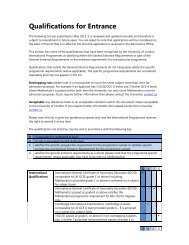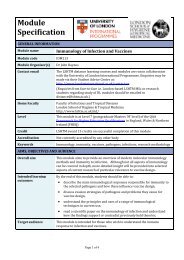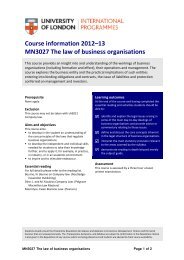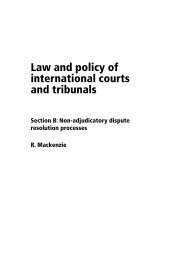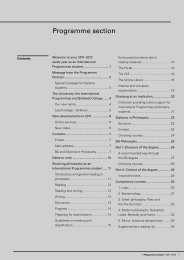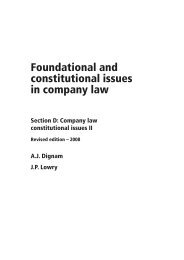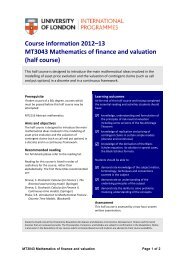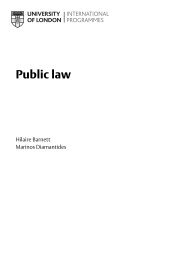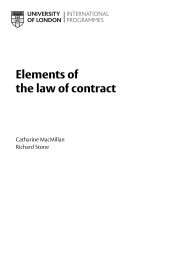Introduction to computer systems architecture and programming
Introduction to computer systems architecture and programming
Introduction to computer systems architecture and programming
You also want an ePaper? Increase the reach of your titles
YUMPU automatically turns print PDFs into web optimized ePapers that Google loves.
168 <strong>Introduction</strong> <strong>to</strong> <strong>computer</strong> <strong>systems</strong> <strong>architecture</strong> <strong>and</strong> <strong>programming</strong><br />
Machine language<br />
At this point, you should recall the underlying idea <strong>and</strong> the main<br />
components of the Von Neumann <strong>architecture</strong> as introduced in Chapter<br />
1: The <strong>computer</strong> s<strong>to</strong>res the program code with the data in the main<br />
memory, <strong>and</strong> the CPU controls the execution of this code by first loading<br />
(fetching) the code for an instruction from the memory in<strong>to</strong> the registers<br />
of the CPU, decoding the instruction, <strong>and</strong> then executing it. Hence<br />
program execution involves the repetition of these three steps: fetching,<br />
decoding, executing. The processing required for a single instruction is<br />
sometimes also referred <strong>to</strong> as an instruction cycle.<br />
CPUs are designed <strong>to</strong> underst<strong>and</strong> a fixed number of instructions. These<br />
instructions (that are fetched, decoded <strong>and</strong> executed) need <strong>to</strong> be<br />
represented as bit patterns in order for them <strong>to</strong> be s<strong>to</strong>red <strong>and</strong> for the CPU<br />
<strong>to</strong> underst<strong>and</strong> them (in the same way as data needs <strong>to</strong> be represented<br />
in binary form). The collection of instructions a CPU can underst<strong>and</strong> is<br />
known as the CPU’s instruction set. The low-level representation of a<br />
CPU’s instruction set is known as the machine language of a <strong>computer</strong>.<br />
Obviously, it is hard for us <strong>to</strong> write instructions in binary form directly.<br />
A much more readable form of machine language is what we refer <strong>to</strong> as<br />
assembly language. Assembly language uses mnemonic (memorable)<br />
code words <strong>to</strong> describe an instruction. For example, an assembly language<br />
may express the moving of the contents of register 1 <strong>to</strong> register 2 as MOV<br />
R1, R2. It is then the task of an assembler <strong>to</strong> translate the assembly<br />
language code in<strong>to</strong> the machine code 0100000000010010.<br />
The next section gives you an insight in<strong>to</strong> the kind of instructions that<br />
form part of a typical instruction set.<br />
Machine instructions – an overview<br />
At the most fundamental level, the actions that are performed by the<br />
CPU are rather limited, <strong>and</strong> hence the instruction set is surprisingly<br />
small. The list below summarises the kind of instructions that constitute<br />
an instruction set <strong>to</strong>gether with concrete examples (using mnemonic<br />
representation) for each kind (Stallings 2010).<br />
• Processor–memory transfer instructions: data may be transferred from<br />
the CPU <strong>to</strong> memory or vice versa.<br />
Example: MOVE<br />
• Processor–input/output (I/O) transfer: data may be transferred from<br />
the CPU <strong>to</strong> external devices (e.g. printer, moni<strong>to</strong>r) or received from<br />
external input devices (e.g. keyboard, scanner).<br />
Examples: READ, WRITE<br />
• Arithmetic or logic operations: these actions involve the common<br />
arithmetic operations (e.g. addition) <strong>and</strong> Boolean operations.<br />
Examples: ADD, AND<br />
• Control flow operations: these control the sequence of the execution<br />
of the program, e.g. they may determine the next location in memory<br />
from which an instruction is being fetched.<br />
Example: BRANCH<br />
32<br />
Program execution<br />
In order <strong>to</strong> gain a better underst<strong>and</strong>ing of how machine language works, let<br />
us now look at an example of how its instructions can be combined <strong>to</strong> carry<br />
out certain tasks. For this purpose we will borrow the machine language<br />
<strong>and</strong> CPU <strong>architecture</strong> proposed in Appendix C of Brookshear (2009).



